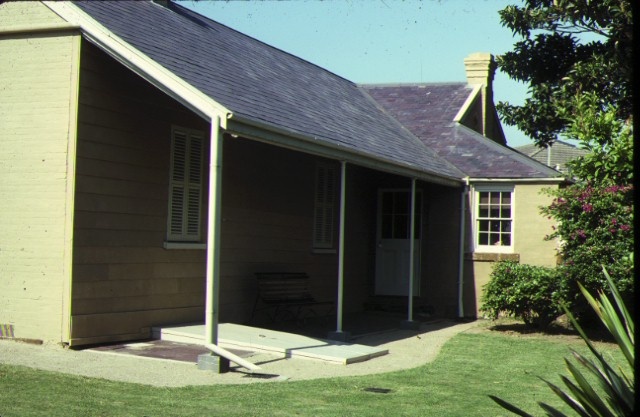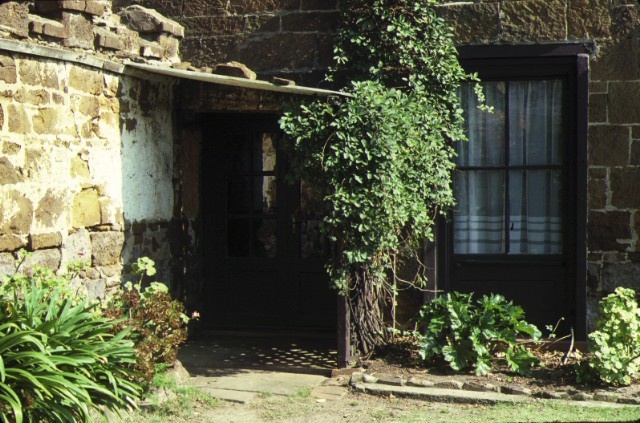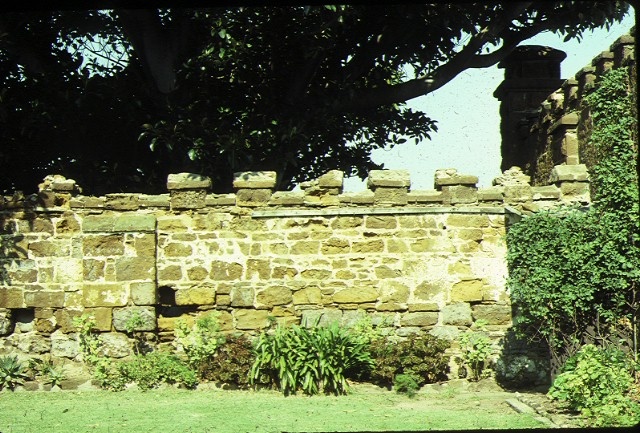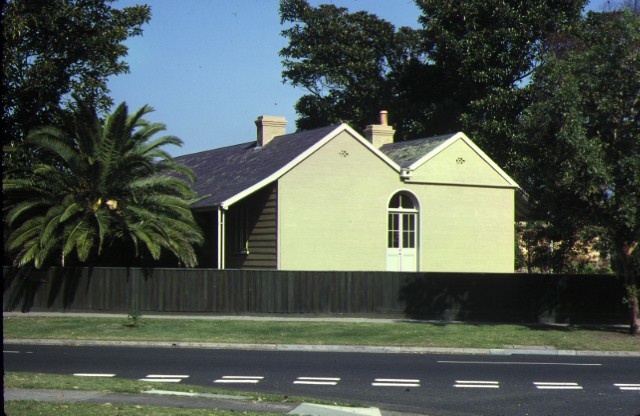BLACK ROCK HOUSE
30 -36 EBDEN AVENUE BLACK ROCK, BAYSIDE CITY
-
Add to tour
You must log in to do that.
-
Share
-
Shortlist place
You must log in to do that.
- Download report









Statement of Significance
What is significant?
Black Rock House at Black Rock was built for Charles Ebden, Victorian squatter, parliamentarian and leading citizen. He had been born in the Cape Colony, settled in Sydney in 1832, became a squatter in southern NSW and northern Victoria, and made an enormous amount of money from pastoralism and astute land dealings. He lived in Melbourne, but in 1856-8 built a holiday house, originally called Ebden Castle, for his family overlooking Port Phillip Bay south of Melbourne, not far from Brighton, which was already a popular retreat for squatters and Melbourne merchants. Clauscen and Becker are sometimes said to be the architects, but this has not been confirmed. The house was built by rock miner John Harty, stonemasons John and Patrick Barrow, and carpenter James Horan. Sir Henry Barkly, Governor of Victoria from 1857 to 1863, rented it for six months as a seaside residence, making it the first country house occupied by any Victorian Governor. It remained in the Ebden family until 1910. Professor (later Sir) Peter McCallum bought it in 1931, and did much to restore the buildings, which had earlier been threatened with demolition, and also the garden.
Black Rock House consists of two buildings linked by a walkway. The family living quarters were in a T-shaped single storey house in a simple colonial vernacular style, constructed with brick gable end walls and weatherboard infill walls, timber-lined and with a double gable slate roof. There is a verandah paved with Scottish stone around three sides of this, part of it carried on distinctive simple slender iron columns. The two principal rooms are on the south side of the house, overlooking the bay, and are separated from the bedroom wing by a wide entrance hall. The front entrance has a classical inspired doorway of unusual design with pilasters and entablature. There is a cellar under the principal rooms. The house is joined by means of a covered walkway about twelve metres long to a rectangular stable and service block. This is surrounded by a high castellated stone wall of random coursed local ironstone with prominent piers and massive timber gates, which was probably influenced by homestead architecture in Ebden's native South Africa. This block has an internal courtyard which had stables along one side, service quarters and kitchens on two sides, and may once also have been used for large-scale entertaining. The house is set in a garden with mature trees.
How is it significant?
Black Rock House is of architectural and historical significance to the State of Victoria.
Why is it significant?
Black Rock House is historically significant as one of a small number of properties in this area which survive from the earliest phase of settlement. It is also significant for its associations with Charles Ebden, an eminent and extremely wealthy pioneer pastoralist, politician, successful businessman and notable member of colonial society.
Black Rock House is architecturally significant as a unique combination of an early house in a simple colonial vernacular style with a more elaborate picturesque castellated stables and service building, the form of which was probably derived from South African antecedents. The house is an excellent example of early construction practice, with timber stud walls clad with deep weatherboards and with papered hessian covered boards internally. The cast iron verandah columns are believed to be unique. The stable court is a rare example of the use of local ironstone and is of note both for the scale of the walls and the pine detailing of the piers.
[Online Data Upgrade Project 2004]
-
-
BLACK ROCK HOUSE - History
Black Rock House at Black Rock was built for Charles Ebden, Victorian squatter, parliamentarian and leading citizen. He had been born in the Cape Colony, settled in Sydney in 1832, became a squatter in southern NSW and northern Victoria, and made an enormous amount of money from pastoralism and astute land dealings. He lived in Melbourne, but in 1856-8 built a holiday house, originally called Ebden Castle, for his family overlooking Port Phillip Bay south of Melbourne, not far from Brighton, which was already a popular retreat for squatters and Melbourne merchants. Clauscen and Becker are sometimes said to be the architects, but this has not been confirmed. The house was built by rock miner John Harty, stonemasons John and Patrick Barrow, and carpenter James Horan. Sir Henry Barkly, Governor of Victoria from 1857 to 1863, rented it for six months as a seaside residence, making it the first country house occupied by any Victorian Governor. It remained in the Ebden family until 1910. Professor (later Sir) Peter McCallum bought it in 1931, and did much to restore the buildings, which had earlier been threatened with demolition, and also the garden.
The draft statement of significance and the above history were produced as part of an Online Data Upgrade Project 2003. Sources were as follows:
Allom Lovell & Associates, ‘Black Rock House 34 Ebden Avenue Black Rock. Conservation Management Plan’, October 2003.
Kerry Jordan, ‘Houses and Status. The Grand Houses of Nineteenth Century Victoria’, PhD, University of Melbourne, 2004.BLACK ROCK HOUSE - Permit Exemptions
General Exemptions:General exemptions apply to all places and objects included in the Victorian Heritage Register (VHR). General exemptions have been designed to allow everyday activities, maintenance and changes to your property, which don’t harm its cultural heritage significance, to proceed without the need to obtain approvals under the Heritage Act 2017.Places of worship: In some circumstances, you can alter a place of worship to accommodate religious practices without a permit, but you must notify the Executive Director of Heritage Victoria before you start the works or activities at least 20 business days before the works or activities are to commence.Subdivision/consolidation: Permit exemptions exist for some subdivisions and consolidations. If the subdivision or consolidation is in accordance with a planning permit granted under Part 4 of the Planning and Environment Act 1987 and the application for the planning permit was referred to the Executive Director of Heritage Victoria as a determining referral authority, a permit is not required.Specific exemptions may also apply to your registered place or object. If applicable, these are listed below. Specific exemptions are tailored to the conservation and management needs of an individual registered place or object and set out works and activities that are exempt from the requirements of a permit. Specific exemptions prevail if they conflict with general exemptions. Find out more about heritage permit exemptions here.Specific Exemptions:General Conditions: 1. All exempted alterations are to be planned and carried out in a manner which prevents damage to the fabric of the registered place or object. General Conditions: 2. Should it become apparent during further inspection or the carrying out of works that original or previously hidden or inaccessible details of the place or object are revealed which relate to the significance of the place or object, then the exemption covering such works shall cease and Heritage Victoria shall be notified as soon as possible. Note: All archaeological places have the potential to contain significant sub-surface artefacts and other remains. In most cases it will be necessary to obtain approval from the Executive Director, Heritage Victoria before the undertaking any works that have a significant sub-surface component.General Conditions: 3. If there is a conservation policy and planall works shall be in accordance with it. Note:A Conservation Management Plan or a Heritage Action Plan provides guidance for the management of the heritage values associated with the site. It may not be necessary to obtain a heritage permit for certain works specified in the management plan.
General Conditions: 4. Nothing in this determination prevents the Executive Director from amending or rescinding all or any of the permit exemptions. General Conditions: 5. Nothing in this determination exempts owners or their agents from the responsibility to seek relevant planning or building permits from the responsible authorities where applicable. Minor Works : Note: Any Minor Works that in the opinion of the Executive Director will not adversely affect the heritage significance of the place may be exempt from the permit requirements of the Heritage Act. A person proposing to undertake minor works must submit a proposal to the Executive Director. If the Executive Director is satisfied that the proposed works will not adversely affect the heritage values of the site, the applicant may be exempted from the requirement to obtain a heritage permit. If an applicant is uncertain whether a heritage permit is required, it is recommended that the permits co-ordinator be contacted.
-
-
-
-
-
DAVID GODSELL HOUSE
 Victorian Heritage Register H2379
Victorian Heritage Register H2379 -
BLACK ROCK BURIAL MARKERS
 Victorian Heritage Inventory
Victorian Heritage Inventory -
Black Rock House
 National Trust H0216
National Trust H0216
-
'Altona' Homestead (Formerly 'Laverton' Homestead) and Logan Reserve
 Hobsons Bay City
Hobsons Bay City
-
-











